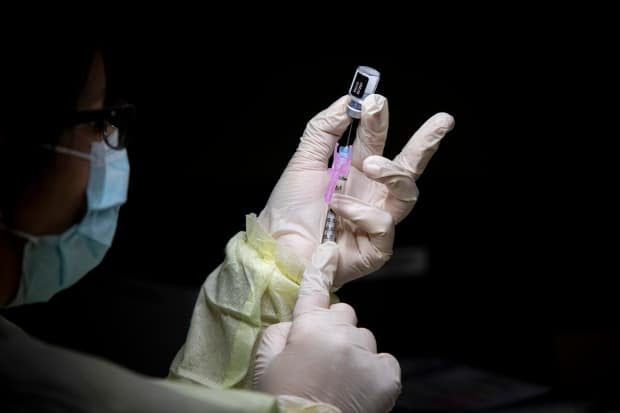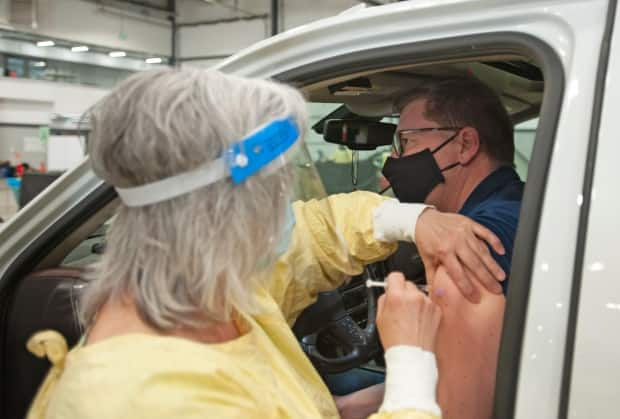As Manitoba mulls changing its vaccine priorities, it's 'all hands on deck' next door in Saskatchewan

In Saskatchewan you can book an appointment to get your COVID-19 vaccine, visit a walk-in site or sit in your car at a first-come, first-served drive-thru.
The options make getting the vaccine more accessible, according to Nazeem Muhajarine, an epidemiologist and professor at the University of Saskatchewan who has also been part of an advisory committee on the province's immunization program.
"The principle is all hands on deck, get as many vaccine doses into people's arms as quickly as possible, all over the province," he said.
In Saskatchewan, your eligibility for a vaccine could depend on where you go for the shot.
For example, people aged 48 and older could book an appointment on Friday, but the drive-thru site in Regina was open for residents aged 46 to 54 only, until it ran out of doses that night. The Saskatchewan Health Authority said its closure is temporary.

Muhajarine knows someone who got their vaccine by bike at one of province's drive-thru clinics.
"She asked, 'I'm on a bike … I'm pedaling through, could I get it?' and yes, she got it," he said.
The speed with which more infectious coronavirus variants of concern are spreading in Canada is making the need to get people vaccinated more urgent. Now that an increasing number of older people are immunized, provinces are faced with choosing who's next on the priority list.
Muhajarine thinks Saskatchewan's COVID-19 immunization campaign has been successful so far.
As of April 16, Manitoba ranked ninth among Canadian provinces in vaccine administration per capita, with 23,038 doses in the arms of every 100,000 citizens. Saskatchewan ranked first by administering 27,471 doses for every 100,000 of its residents.
Still, Muhajarine said vaccine supply is a challenge.
"I think that has really limited the pace in which … vaccines have been delivered to people."
And he sees a need to open Saskatchewan's eligibility to include more essential workers and target hot spot areas where people could be more at risk for COVID-19.
As of Saturday, in Manitoba, those aged 56 and older, and First Nations people 36 and over, can book an appointment to get a vaccine at a supersite or pop-up clinic.
Manitoba has also prioritized certain groups including health-care workers and those living in care homes. People age 55 to 64 with certain medical conditions, and anyone 65 or older, can book appointments at medical clinics and pharmacies to receive the AstraZeneca-Oxford vaccine.
But changes to the province's rollout plan are coming, as Manitoba enters a third wave and more infectious coronavirus variants of concern become more of a threat.
The province's vaccine task force said earlier this week there are plans to conduct fewer pop-up clinics in rural and remote areas in Manitoba and instead pump out more vaccines in places like Winnipeg, where the virus is spreading faster.
Manitoba also announced it's opening eligibility to provide vaccines to police officers and firefighters, as well as all adults living in and working front-line jobs in certain geographical areas deemed high risk for COVID-19 transmission.
More details about what jobs and what areas will be covered are expected on Wednesday.
"Certainly what we've seen as far as disease transmission in some way or another will be one of the driving factors, but I expect their will be other factors that get looked at as well," Dr. Joss Reimer, medical lead of Manitoba's vaccine task force, said Friday.
Dr. Brian Conway, medical director of the Vancouver Infectious Diseases Centre, said British Columbia's initial vaccine program was largely aged based and focused on protecting those most at risk for hospitalization and death. But there has been a move to target some hot spots such as Whistler.
"Vaccine was taken from the supply that was available and reassigned to deal with outbreaks that would be difficult to control without us having vaccinated the population," said Conway.

Vaccines must continue to be administered to those who are at higher risk of hospitalization and death, but the strategy should also include controlling transmission, he said.
"The evolution of the pandemic is now more complicated than it used to be and it's making the situation difficult to implement on a daily basis in terms of public health measures, vaccine rollout and the like."
The biggest problem in Canada's rollout of vaccine is there's not enough of it, he said.
"We need to advocate very strongly for identifying sources of vaccine that could be available to us immediately so that we can start using the vaccine more effectively as a tool to reduce transmission."
Conway said people should also be looking at ways to reduce their interactions with others on a daily basis.
The variants, he said, have changed the third wave immensely,
"We were engaging in behaviours on a day-to-day basis that were just within, or just outside of, the public health regulations and without the variants these behaviours were safe and didn't lead to viral transmissions," he said.
"If there's a virus around that's two or three times more contagious, these behaviours now become inherently less safe."

